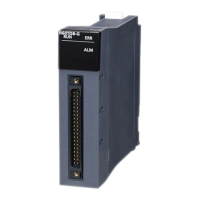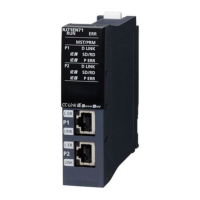10 TEST FUNCTION
10.2 Device test with execution conditions
159
10
Data that can be set
The following tables list the data that can be set for the device test with execution conditions.
■Devices that can be set
*1 For bit devices, digit specification is allowed for K1 to K8 only.
*2 For word devices, bit specification is allowed.
*3 A local device, indirectly-specified device, or index-modified device can also be specified. However, a device modified with a local index
register cannot be specified.
■Labels that can be set
*1 Only labels that exist in the read project can be specified.
*2 Labels of a program block can be specified.
*3 Digit-specified labels cannot be specified.
*4 Bit specification is allowed.
*5 Specify the array element.
*6 Specify the structure member.
Type Device
*3
Bit device
*1
X, DX, Y, DY, M, L, F, SM, V, B, SB, T (contact), ST (contact), C (contact), LT (contact), LST (contact), LC (contact), FX, FY, Jn\X,
Jn\Y, Jn\SB, Jn\B
Word device
*2
T (current value), ST (current value), C (current value), D, SD, W, SW, RD, R, ZR, Z, FD, Un\G, Jn\W, Jn\SW, U3En\G, U3En\HG
Double-word device LT (current value), LST (current value), LC (current value), LZ
Type
*1*2
Class Data type
Global label • VAR_GLOBAL
• VAR_GLOBAL_RETAIN
■Primitive data type
•Bit
*3
• Word (signed)
*4
• Double word (signed)
• Word (unsigned)
*4
• Double word (unsigned)
• Single-precision real number
• Double-precision real number
• Timer type
• Retentive timer type
• Counter type
• Long timer type
• Long retentive timer type
• Long counter type
■Array
*5
■Structure
*6
Local label • VAR
• VAR_RETAIN

